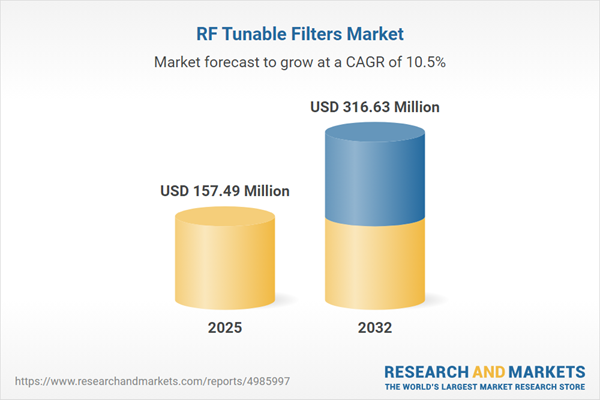Speak directly to the analyst to clarify any post sales queries you may have.
The RF tunable filters market is critical for modern enterprises striving to create resilient, scalable wireless infrastructure. These solutions help organizations address current and emerging connectivity demands in business environments where reliability and adaptability are paramount.
Market Snapshot: RF Tunable Filters Market Outlook and Growth Potential
The global RF tunable filters market is advancing quickly, driven by continuous improvements in semiconductor technology and ongoing investments in 5G and 6G network developments. Sectors such as telecommunications, aerospace, and industrial IoT increasingly rely on tunable filters to address evolving spectrum allocations and connectivity standards. As enterprise requirements shift, there is increased demand for adaptable equipment that supports regulatory compliance while maximizing efficiency and reliability. Solution providers meet these needs by launching flexible filter technologies that facilitate scalable wireless communication. These evolving trends enable decision-makers to futureproof digital infrastructure and proactively respond to next-generation network deployment challenges.
Scope & Segmentation of the RF Tunable Filters Market
- Frequency Bands: Covering High Band, Mid Band, and Low Band (including LF and VHF), RF tunable filters support diverse operational needs, from industrial IoT to advanced electronics, where frequency agility is increasingly vital. This broad frequency support allows seamless integration of legacy and new systems, supporting infrastructure modernization.
- Filter Types: The technology portfolio includes Bulk Acoustic Wave (FBAR, SMR), dielectric, ceramic, resonator, MEMS-based, and Surface Acoustic Wave filters. Enterprises benefit from smaller components, better integration, and reduced power consumption, making these solutions well-suited for mission-critical and high-density applications requiring performance consistency.
- Applications: RF tunable filters help safeguard robust communications across aerospace, defense, radar, and secure networks. Their performance also extends to automotive connectivity, satellite systems, and telecommunications infrastructure, where maintaining reliable network quality is essential to avoid service interruptions.
- Geographies: Market activity spans the Americas, Europe, Middle East, Africa, and Asia-Pacific. Influential regional drivers include China, India, Japan, and South Korea. These regions shape procurement strategies, technology innovation, and regulatory alignment, which directly influence global competitiveness and adoption rates.
- Leading Companies: Key participants include Qorvo, Inc., Murata Manufacturing Co., Ltd., Broadcom Inc., Skyworks Solutions, Inc., TDK Corporation, NXP Semiconductors N.V., Analog Devices, Inc., Texas Instruments Incorporated, STMicroelectronics N.V., and Infineon Technologies AG. Strategic partnerships and market positioning by these firms directly impact competition and the global supply of filtering solutions.
Key Takeaways for Senior Decision-Makers
- Advances in acoustic wave and MEMS-based filter designs help organizations sustain reliable communications and improve network energy efficiency, even as operational requirements evolve.
- Enhanced frequency management capabilities support streamlined regulatory compliance, enabling secure communication across regions with differing connectivity standards.
- Collaboration between RF tunable filter vendors and telecom providers is accelerating technology innovation, strengthening supply chain robustness, and ensuring systems align with prevailing industry requirements.
- The adoption of software-defined systems with AI-driven calibration tools reduces manual tasks, facilitating scalable network rollouts and more consistent site-level performance.
- Deployment of regionalized supplier strategies enables organizations to adapt more quickly to supply chain fluctuations and changes in regulatory policy.
- Scalable solutions within the RF tunable filter market equip enterprises with a robust foundation to address rising needs for secure, resilient digital infrastructure.
Tariff Impact: Navigating New Supply Chain Realities
Changes in U.S. tariff policies have prompted companies in the RF tunable filters sector to adjust procurement and manufacturing strategies. Increased investment in local assembly and stringent system validation practices is fostering supply chains that offer enhanced transparency and adaptability. These measures support organizations in mitigating regulatory risks and navigating fluctuating global trade conditions.
Methodology & Data Sources
This analysis is based on executive interviews, comprehensive technical assessments, manufacturer disclosures, and unique logistics data. All research scenarios are rigorously cross-validated, providing actionable guidance for leaders responsible for wireless infrastructure investment in the RF tunable filters market.
Why This Report Matters: Executive Outcomes in the RF Tunable Filters Market
- Delivers clear direction for strategic planning in response to changing frequency needs and evolving regulatory environments, supporting global and regional competitiveness.
- Supports supplier relationship optimization and risk management efforts, particularly as trade landscapes and supply systems adapt.
- Provides senior leaders with specific recommendations for strengthening operational resilience and facilitating digital transformation initiatives.
Conclusion
RF tunable filters are essential for reliable, future-ready wireless networks. This report supplies senior decision-makers with practical market insights to support confident organizational planning amid evolving connectivity and compliance demands.
Additional Product Information:
- Purchase of this report includes 1 year online access with quarterly updates.
- This report can be updated on request. Please contact our Customer Experience team using the Ask a Question widget on our website.
Table of Contents
3. Executive Summary
4. Market Overview
7. Cumulative Impact of Artificial Intelligence 2025
Companies Mentioned
The companies profiled in this RF Tunable Filters market report include:- Qorvo, Inc.
- Murata Manufacturing Co., Ltd.
- Broadcom Inc.
- Skyworks Solutions, Inc.
- TDK Corporation
- NXP Semiconductors N.V.
- Analog Devices, Inc.
- Texas Instruments Incorporated
- STMicroelectronics N.V.
- Infineon Technologies AG
Table Information
| Report Attribute | Details |
|---|---|
| No. of Pages | 188 |
| Published | October 2025 |
| Forecast Period | 2025 - 2032 |
| Estimated Market Value ( USD | $ 157.49 Million |
| Forecasted Market Value ( USD | $ 316.63 Million |
| Compound Annual Growth Rate | 10.4% |
| Regions Covered | Global |
| No. of Companies Mentioned | 11 |









